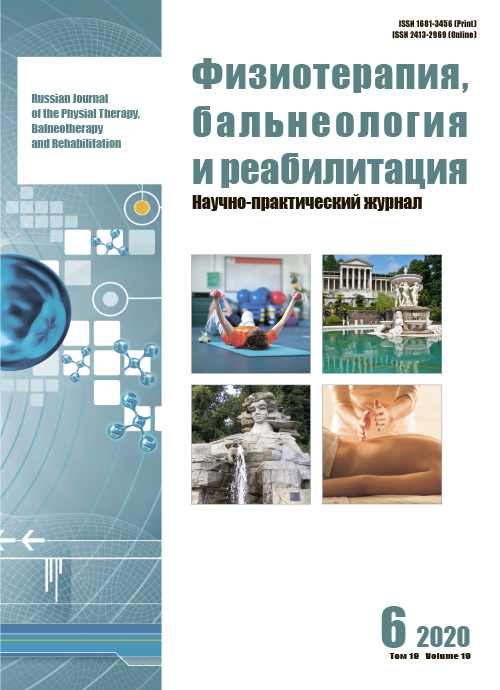Выразительное движение: междисциплинарный взгляд
- Авторы: Зайцева Т.Н.1, Нижельской В.А.2,3, Герасименко М.Ю.1, Сайто М.4
-
Учреждения:
- Российская медицинская академия непрерывного профессионального образования
- Московский государственный университет имени М.В. Ломоносова
- Научно-исследовательский институт нормальной физиологии имени П.К. Анохина
- Dance Science Academy of Japan
- Выпуск: Том 19, № 6 (2020)
- Страницы: 395-399
- Раздел: Обзоры
- Статья опубликована: 15.12.2020
- URL: https://rjpbr.com/1681-3456/article/view/78555
- DOI: https://doi.org/10.17816/1681-3456-2020-19-6-8
- ID: 78555
Цитировать
Полный текст
Аннотация
Цель обзора — познакомить читателей с современными медицинскими и физиологическими подходами к изучению выразительности движений тела человека. Использование таких знаний может способствовать достижению максимального результата в профессиональной деятельности, повышению эффективности обучения, снижению травматизма на занятиях, связанных с физической активностью. Объединение широкого круга специалистов, заинтересованных в развитии техничности и виртуозности исполнения движений, которые составляют основу профессионального мастерства, обсуждение актуальных вопросов применения современных технологий и их имплементации в практику позволит сформировать у специалистов комплексное понимание современных тенденций к изучению выразительного движения в аспекте физиологии и медицины, а также на качественно новом уровне разработать общие подходы к трансляции полученных знаний.
Ключевые слова
Полный текст
Об авторах
Татьяна Николаевна Зайцева
Российская медицинская академия непрерывного профессионального образования
Автор, ответственный за переписку.
Email: zaytn@mail.ru
ORCID iD: 0000-0001-7123-1568
SPIN-код: 9416-4428
к.м.н.
Россия, МоскваВиктор Александрович Нижельской
Московский государственный университет имени М.В. Ломоносова; Научно-исследовательский институт нормальной физиологии имени П.К. Анохина
Email: zaytn@mail.ru
ORCID iD: 0000-0001-7506-5480
SPIN-код: 2890-3053
к.п.н.
Россия, МоскваМарина Юрьевна Герасименко
Российская медицинская академия непрерывного профессионального образования
Email: zaytn@mail.ru
ORCID iD: 0000-0002-1741-7246
SPIN-код: 7625-6452
д.м.н., профессор
Россия, МоскваМанами Сайто
Dance Science Academy of Japan
Email: zaytn@mail.ru
ORCID iD: 0000-0002-3415-111X
Япония, Токио
Список литературы
- Нижельской В.А. Выразительное движение как взаимосвязь двигательных способностей и пластических качеств актера // Вестник Казанского государственного университета культуры и искусств. 2015. № 4-1. С. 52–56.
- Нижельской В.А. О физическом и художественном аспектах выразительного движения // Театр. Живопись. Кино. Музыка. 2016. № 2. С. 165–173.
- Проскуряков В.В. Поиск выразительного движения // Северный регион: наука, образование, культура. 2013. № 1. С. 232–240.
- Айламазьян А.М. О смыслопорождающей роли искусства в жизни человека // Мир психологии. 2018. № 1. С. 241–254.
- Айламазьян А.М. Движение и становление личности // Национальный психологический журнал. 2017. № 2. С. 73–84.
- Айламазьян А.М. Практика музыкального движения как метод самопознания и развития творческой личности // Национальный психологический журнал. 2019. Т. 4. № 4. С. 114–127.
- Сироткина И.Е. «Двигательная культура» как объект науки // Этнографическое обозрение. 2018. № 6. С. 12–24.
- Сироткина И.Е. От контроля сверху к самоорганизации: оттепель и теория управления движениями // Логос. 2020. Т. 30, № 2. С. 129–156.
- Психология спорта: наука, искусство, профессия / под ред. К.А. Бочавера, Л.М. Довжик. Москва, 2019. 270 с.
- Бочавер К.А., Нижельской В.А. Психологические проблемы развития выразительности движений и повышения качества двигательного контроля // Спортивный психолог. 2018. № 3. С. 50–55.
- Нижельской В.А., Ковалева А.В., Панова Е.Н. Влияние представлений чувственно-ориентированных образов на параметры вертикальной позы и биоэлектрической активности головного мозга у актеров в процессе перевоплощения (пилотное исследование) // Национальный психологический журнал. 2020. Т. 2, № 2. С. 148–157.
- Кузнецова А.С., Титова М.А. Эффективная саморегуляция состояния в напряженных условиях как дифференцирующая компетенция // Институт психологии Российской Академии Наук. Организационная психология и психология труда. 2016. Т. 1, № 1. С. 84–109.
- Агапкин С.Н., Мирошников А.Б. Особенности психологического профиля лиц, занимающихся йогой // Спортивный психолог. 2017. № 2. С. 48–52.
- Савенкова Л.Г. Полихудожественное образование как условие введения ребёнка в культуру // Вестник Московского государственного университета культуры и искусств. 2019. № 1. С. 156–163.
- Савенкова Л.Г., Сорокина Ю.В. Развивающая художественная среда и ее влияние на профессиональную деятельность человека // Педагогика искусства. 2019. № 3. С. 124–131.
- Савенкова Л.Г. Художественное событие — современная составляющая интегрированного полихудожественного обучения // Педагогика искусства. 2017. № 3. С. 48–54.
- Нижельской В.А., Кубряк О.В. Исследование опорных реакций и пластической выразительности в преподавании специального курса физической культуры актерам // Вестник спортивной науки. 2019. № 1. С. 86–90.
- Еремушкин М.А., Стяжкина Е.М. Оптимизация двигательных способностей в программах медицинской реабилитации // Арбатские чтения: сборник научных трудов. Москва: Знание-М, 2020. С. 33–40.
- Куликов А.Г., Ярустовская О.В., Герасименко М.Ю., и др. Применение общей магнитотерапии в клинической практике. Учебное пособие. Москва, 2017. 52 с.
- Laban R. The mastery of Movement on the stage. Alton, Hampshire, UK: Dance Books Ltd.; 2011.196 p.
- Law A.H. Meyerhold, Eisenstein and biomechanics: actor training in revolutionary Russia. North Carolina: McFarland&Company; 1996. 282 p.
- Paillard T. Plasticity of the postural function to sport and/or motor experience // Neurosci Biobehavior Rev. 2017. Vol. 72. P. 129–152.
- Ryan R.M., Deci E.L. Intrinsic and extrinsic motivations: Classic definitions and new directions // Contemporary Educational Psychology. 2000. Vol. 25, N 1. P. 54–67.
- Winter D.A. Biomechanics and motor control of human movement. John Wiley & Sons; 2009.
- Nakagawa K., Inui K., Kakigi R. Somatosensory System. Basic Function. In: Tobimatsu S., Kakigi R., eds. Clinical applications of magnetoencephalography. Pt. III, Ch.3. Tokyo etc.: Springer; 2016. P. 55–71.
- Munzert J., Lorey B., Zentgraf K. Cognitive motor processes: the role of motor imagery in the study of motor representations // Brain Res Rev. 2009. Vol. 60, N 2. P. 306–326.
- Барлоу У. Техника Александера. Москва: АСТ, 2009.
Дополнительные файлы







